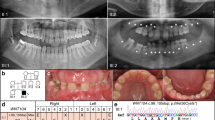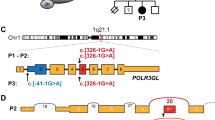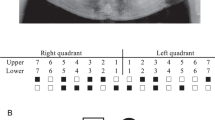Abstract
We identified a frameshift mutation in the paired domain of PAX9 following genome-wide analysis of a family segregating autosomal dominant oligodontia. Affected members have normal primary dentition but lacked most permanent molars.
This is a preview of subscription content, access via your institution
Access options
Subscribe to this journal
Receive 12 print issues and online access
$209.00 per year
only $17.42 per issue
Buy this article
- Purchase on Springer Link
- Instant access to full article PDF
Prices may be subject to local taxes which are calculated during checkout


Similar content being viewed by others
References
Gorlin, R.J., Cohen, M.M. & Levin, L.S. Syndromes of the Head and Neck (Oxford University Press, New York, 1990).
Jorgenson, R.J. J. Am. Dent. Assoc. 101, 283–286 (1980).
Graber, L.W. J. Am. Dent. Assoc. 96, 266–275 (1978).
Vastardis, H., Karimbux, N., Guthua, S.W., Seidman, J.G. & Seidman, C.E. Nature Genet. 13, 417–421 (1996).
Nieminen, P., Arte, S., Pirinen, S., Peltonen, L. & Thesleff, I. Hum. Genet. 96, 305– 308 (1995).
Vastardis, H. Genetic approaches to understanding tooth development: a human MSX1 homeodomain missense mutation causes selective tooth agenesis. Thesis, Harvard Univ. (1996).
Stapleton, P., Weith, A., Urbánek, P., Kozmik, Z. & Busslinger, M. Nature Genet. 3, 292–298 (1993).
Semenza, G.L. PAX Proteins 169–198 (Oxford University Press, New York, 1998).
Peters, H., Neubüser, A., Kratochwil, K. & Balling, R. Genes Dev. 12, 2735–2747 (1998).
Acknowledgements
We thank the family for their cooperation; C. Egger for PAX9 genomic sequence; and D. Nguyen and P. Mai in the Kleberg Genotyping Center. This work was supported in part by a grant from the Kleberg Foundation, Basic Research Grant No. 1-FY98-0119 from the March of Dimes Birth Defects Foundation (P.I.P.), and NIH grants EY00375 (D.W.S.), DE11663 and DE13368 (R.D.S.).
Author information
Authors and Affiliations
Corresponding authors
Rights and permissions
About this article
Cite this article
Stockton, D., Das, P., Goldenberg, M. et al. Mutation of PAX9 is associated with oligodontia. Nat Genet 24, 18–19 (2000). https://doi.org/10.1038/71634
Issue Date:
DOI: https://doi.org/10.1038/71634
This article is cited by
-
Compound heterozygous WNT10A missense variations exacerbated the tooth agenesis caused by hypohidrotic ectodermal dysplasia
BMC Oral Health (2024)
-
The genetic basis of hypodontia in dental development
British Dental Journal (2023)
-
An in vitro and computational validation of a novel loss-of-functional mutation in PAX9 associated with non-syndromic tooth agenesis
Molecular Genetics and Genomics (2023)
-
The phenotype and genotype of PAX9 mutations causing tooth agenesis
Clinical Oral Investigations (2023)
-
Genome-wide screening for deubiquitinase subfamily identifies ubiquitin-specific protease 49 as a novel regulator of odontogenesis
Cell Death & Differentiation (2022)



